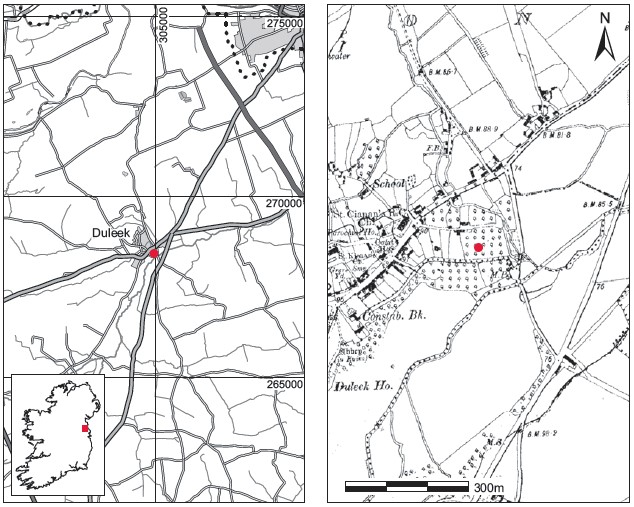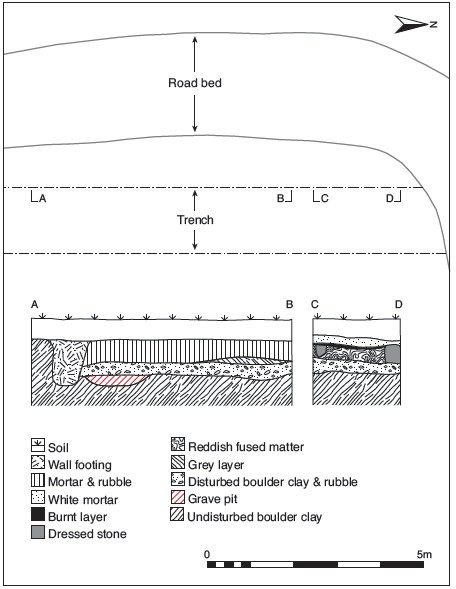County: Meath Site name: COMMONS, DULEEK, CO. MEATH
Sites and Monuments Record No.: SMR ME027-038027ME027-038 Licence number: E1131
Author: MICHAEL RYAN
Site type: Graves of indeterminate date
Period/Dating: —
ITM: E 704875m, N 768442m
Latitude, Longitude (decimal degrees): 53.655227, -6.413433
Introduction
In March 1973 human remains were discovered during the digging of a trench for sewerage pipes for a housing development near Duleek, Co. Meath. The burials were removed from their context and immediately reburied under the ballast supporting the pipe. At least eight extended inhumations were discovered, one of which had been placed in a shallow pit. The discovery was reported to the NMI by Enda O’Boyle and the site was investigated by Michael Ryan on 28 March 1973. All of the bones had been removed and reburied, but some information was obtained from the workers on the site. The human remains were examined by Professor C.A. Erskine. This report is based on Michael Ryan’s report and on Erskine’s examination of the human remains.
Location (Fig. 6.36)
The site was in the townland of Commons, on the outskirts of Duleek village, east Co. Meath.64 The first edition OS 6in. sheet shows that the site was occupied by a mature orchard, which survived until recent years. The burials were discovered on the site of a medieval grange that was granted c. 1180 to the Augustinian Priory of Llanthony Secunda in Gloucestershire.65 It is possible that the burials are connected with this foundation.
Description of site
At least eight extended inhumations (1973:9–10.1–7) were found, and of these at least two

were aligned east/west; where in other cases it could be deduced, they were aligned north/south with the head to the north (Fig. 6.37). At least one of the burials had been placed in a shallow pit at a depth of 1m below ground level. The pit measured 0.25m in surviving and was stratified below a deposit of soil that yielded evidence of the destruction of a building. The spoil on the site was also examined and was found to contain some oyster shells, roofing slates, eighteenth/nineteenth-century pottery, bottle glass and a portion of a red ceramic floor tile. All the visible remains were collected and brought to the Museum. Both female and male remains were identified.
Comment
As the site had been an established orchard, the modern finds of pottery and shells etc. may relate to the dumping of household refuse. In the absence of any associated finds or other dating evidence the burials must be considered undated, although the possible connection with the priory is noted above
HUMAN REMAINS
C.A. ERSKINE
1973:9
One collection consists of seventeen fairly large fragments of skeletons of four individuals and three animal bones: one femoral head belongs to a male of about twenty years of very heavy

build, and a second similar specimen also to a male of heavy build. The remaining two groups belong to small young adult females. Parts of femur, tibia, humerus and ulna belong to these groups. The fragments of pelvis with acetabulum belong to the massive male. A fragment sacrum belongs to the smaller male and shows the abnormality of sacralisation. The fragment base of skull with this collection is probably female.
1973:10.1–6
Eleven adult skull fragments belonging to at least six individuals, of which the fragment 1973:10.1 shows some special features.
1973:10.1
This consists of a large part of the vault of an adult skull, mainly pieces of the two parietal and occipital bones. There is considerable post-mortem pitting and flaking, especially on the outer surface. Meningeal grooves are well marked, especially on the right side; on the left these are probably obscured by pitting. Marked pneumatisation of mastoid. Well-marked fossae, but abnormal for the occipital poles of the brain with—
(a) an unusually deep groove at the junction of the parietal and occipital squama;
(b) on the outer surface, the occipital squama appear to be much more swollen or thickened and to be displaced outwards about 1cm along the parieto-occipital (lambdoid) suture. Though the occipital may be somewhat thicker than usual, it is comparable in thickness with the parietals.
(c) Another unusual feature is present in the saggital suture—the line of fusion has unusually wide interdigitations forming a striped appearance.
Interpretation of the swollen appearance of the occipital bone leads to the conclusion that it was not traumatic or neoplastic either in the bone itself or in the brain (no evidence of pressure on the vault), with secondary displacement of the squama. The pitting and erosion are not typical of an inflammatory condition (osteitis). Radiography of the skull suture lines in children of about four years with blood diseases which produce reactive vascular changes and bone absorption show a peculiar dihesive type of suture line which closely resembles the saggital suture in this specimen. A growth disturbance of nutritional origin anaemia or vitamin deficiencies at a critical stage of the growth period of the subject might lead to displacement and irregular closure of the lambdoid suture on recovery. Lesser degrees of the apparent occipital displacement have been observed, though rarely, in otherwise normal skulls.
1973:10.2
Fragment consisting of the greater part of the frontal bone.
1973:10.3
Fragment of skull, probably female, with parts of frontal bone, nasal and frontal process of maxillary and showing a metopic suture and post-mortem internal pitting.
1973:10.4
Fragment consisting of the greater part of the frontal and nasal bones with soil infiltration flaking; suture lines are not distinguishable; frontal sinus well developed—probably male, aged 40–50 years.
1973:10.5
Fragment of skull consisting of a nearly complete left parietal bone with well-marked meningeal grooves; some post-mortem surface pitting.
1973:10.6
Large fragment of greater part of two parietals and occipital, probably female, with wellmarked sutures and arachnoid fossae.
1973:10.7
Of five fragments of flat bones of the skull, four show recent breaks. The two larger fragments are part of the left and right parietal bones with deep meningeal markings; the two smaller fragments show no special peculiarities.
64. Parish of Duleek, barony of Lower Duleek. SMR ME027-038027-. IGR 304947 268424. Although the site is recorded in the file as Abbeyland townland, the coordinates provided place the site across the townland boundary, in the townland of Commons.
65. ME027-038——.